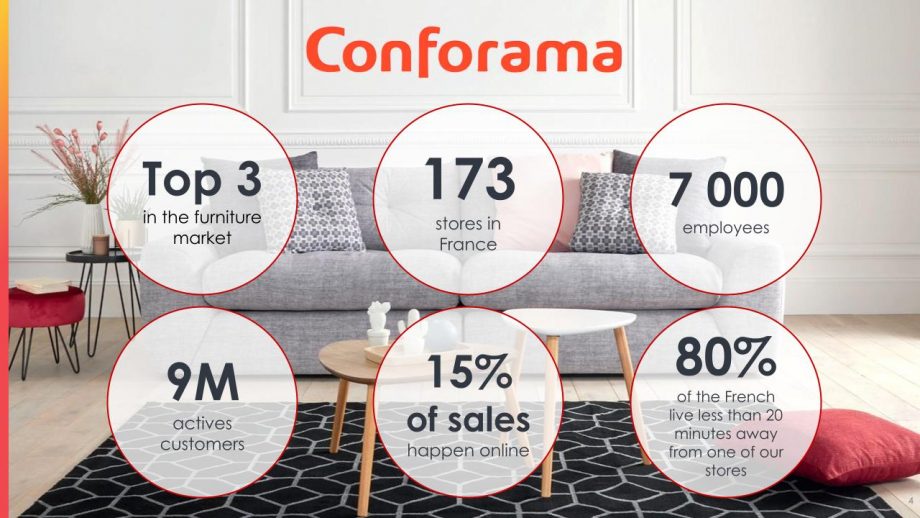How Conforama made CRM a critical component of its brand strategy


Monaco is famous for its yachts and car races, but it holds a dear place in our hearts for another reason: it’s where one of the best European eCommerce trade shows y is held every year. Well, almost every year: Covid got the best of the 2020 edition.
This year’s show was particularly thrilling not only because it was one of our first post-Covid in-person events, but because Mélodie Charles, CMO of Conforama, took the time to sit down with Tinyclues’ founder, David Bessis, to discuss brand positioning and CRM strategy.
For those unfamiliar with Conforama: it’s one of France’s largest furniture and home decor retailers. Think Best Buy, but for furniture.

Here goes a summary for this fascinating chat:
Melodie noted that Conforama recently started working on a major shift in positioning, with a simple, powerful brand promise: Conforama will make accessible what people like the most, at the best price. Conforama has made it its mission to make trends affordable.
Conforama has an enormous customer list that they’ve been building out for over 10 years now. Since they’re able to associate an impressive 90% of the purchases made in-store with a customer ID, their customer data is really rich.
So it was obvious that CRM would have a significant role in the repositioning effort.
Indeed, before 2018, Conforama was sending 4 to 5 emails per week, mostly full-base, to about 3 million customers. This represented about 90% of its CRM messages. The other 10% were triggers – messages like abandoned cart or abandoned browsing emails. This heavy email load was making for significant marketing pressure – the customer base was showing signs of exhaustion and performance was on the decline.. Conforama needed to both decrease its number of emails and make them more relevant.
Partner brands were increasingly asking for access to the customer base by way of dedicated campaigns showcasing either their respective brands or specific products – and while Conforama highly values partner relationships and puts a high priority on helping them achieve their goals, the CRM plan was getting a little crowded!
David noted that “marketing automation” is all the rage, and that big Marketing Clouds love showing off how ‘customer-centric’ triggers and journeys are… but these types of messages actually only represent about 10% of a given CRM team’s communications, just like for Conforama.
The other 90%? They’re the submerged part of the iceberg. The CRM that marketing teams are ashamed of. The mass emailing. Nobody talks about it and yet it’s such a massive part of any CRM strategy! Category managers want their offers to be highlighted. Partners want their brands to be promoted. And suddenly the needs of the customer are playing second fiddle to the needs of the business. Every CRM team under the sun has to navigate the delicate balance between business-centricity and customer-centricity. Automation can’t do that for them.
So how can CRM teams take these messages and make them smarter, more data-driven, more relevant?
They still send some full-base emails, to make sure the main commercial offers and news are shared with the customer base – typically, one per week, on Tuesdays.
But now, they can follow up on these full-base emails with targeted campaigns that echo the mass message, with much more specific offers for which it’s critical for the team to only address a smaller audience. Use cases include:
On top of alleviating marketing pressure, these targeted campaigns allow Conforama to demonstrate a higher level of expertise and relevancy to their customers, in alignment with the new brand positioning.
Moving from mass emailing to hyper-targeted CRM campaigns was a disruptive change. And actually, to get all internal stakeholders aligned, Mélodie said, “good” results wouldn’t be enough. Luckily, Mélodie’s team got great results during the pilot phase, enough to trigger the adoption of Splio.
Even so, change doesn’t happen overnight. Campaign by campaign, week by week, Mélodie’s team works at spreading the word internally and reporting on results to drive the point home to every stakeholder – including the commercial teams who are in charge of negotiating with the partner brands – that targeted campaigns perform better than full-base. Meaning, indeed, that sending fewer messages generates better results!
The continued evangelization is paying off. Now, Mélodie reports, partner brands are absolutely in sync with sending targeted campaigns – when it was a much touchier subject just a couple of years ago.
This became especially clear in the weeks leading up to Black Friday 2021: so many partner brands reached out to message Conforama’s customer base that Conforama had to work on smaller volumes than usual (100 to 200k instead of 400 to 500k). And the brands absolutely went for it because they knew that the performance would be great!
In other words, Conforama is selling fewer messages for the same partner revenue… because thanks to sophisticated targeting, partner brands are also winning, and they now value targeting just as much as Conforama’s CRM team.
Since this strategy works so well, Conforama doesn’t even send full-base partner campaigns anymore, only AI-powered targeted campaigns. This way, the team can send many more campaigns (to a lesser volume each), which results in a more relevant customer experience, and a much more sustainable CRM practice.
The implementation of such a sophisticated, personalized campaign plan to improve customer experience, support the repositioning effort, and fast-track partner marketing relationships, wouldn’t have been possible without a platform like Splio.
In order to succeed with such a strategy, David explained, brands need to change the way they think about targeting. Traditionally, targeting was achieved by building audiences through the addition of explicit criteria. But how would you go about picking criteria to decide who should be in the audience for a Samsung TV? You could select people who’ve browsed TVs in the past week… but they’re already in your retargeting and your triggers. And the volume is going to be ridiculously low. Who else? It’s really hard to build an audience this way – not to mention that criteria-based audience building is nothing more than industrialized bias.
Using Splio, however, Mélodie’s team was able to leverage Conforama’s data to produce a much more powerful targeting approach. Essentially, the platform applies Deep Learning to Conforama’s first-party data (all of it, not a few arbitrarily handpicked dimensions) to predict real propensity to buy for the products showcased in their campaigns.
This impacts performance, of course, but also agility. Manual audience building would be impossible with such a volume of campaigns… The platform’s streamlined audience-building process allows for huge gains in productivity.
To conclude the chat, Mélodie shared that Conforama has launched a project around the creation of a whole data ecosystem to align and match as much customer data as possible (transactions, browsing, logistics…) within Google Cloud Platform.
Once the data is available in GCP, it will be even easier to feed it to Splio’ predictive engine and improve performance even further!